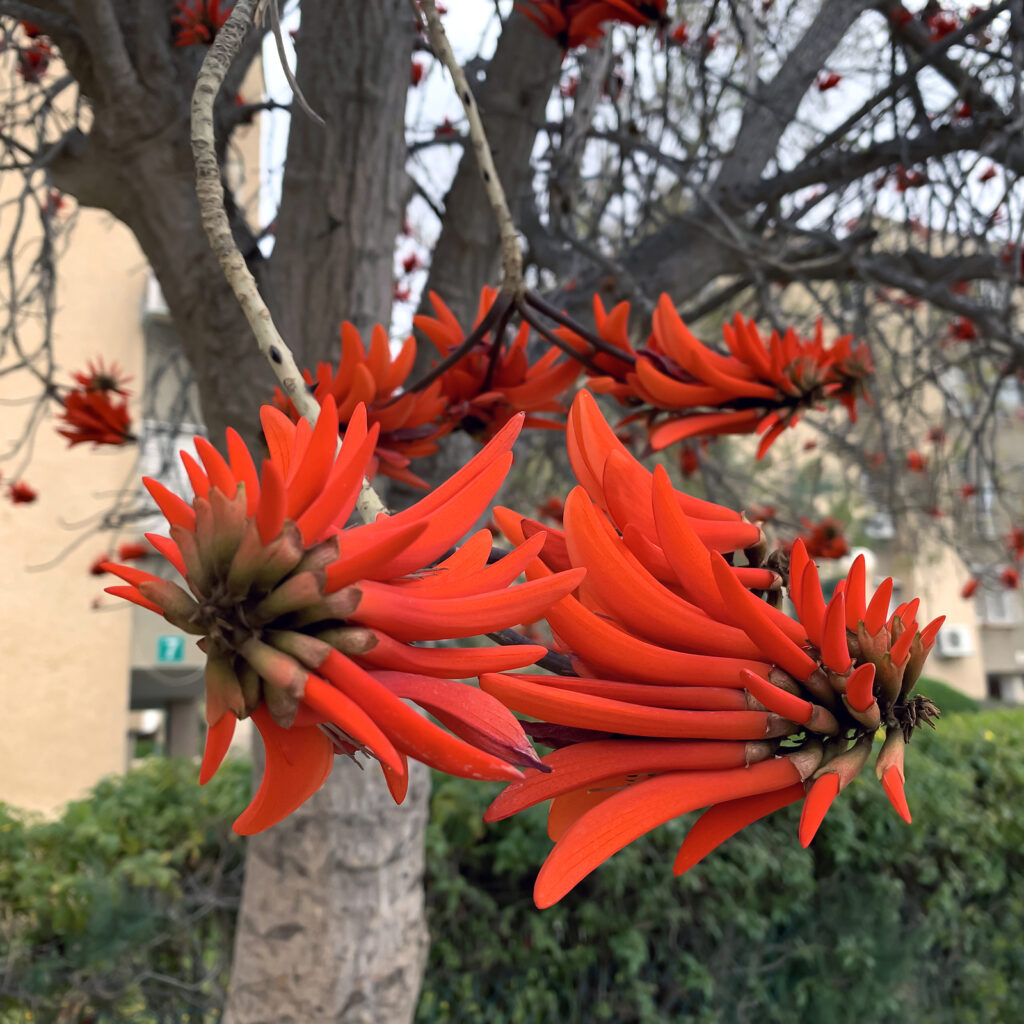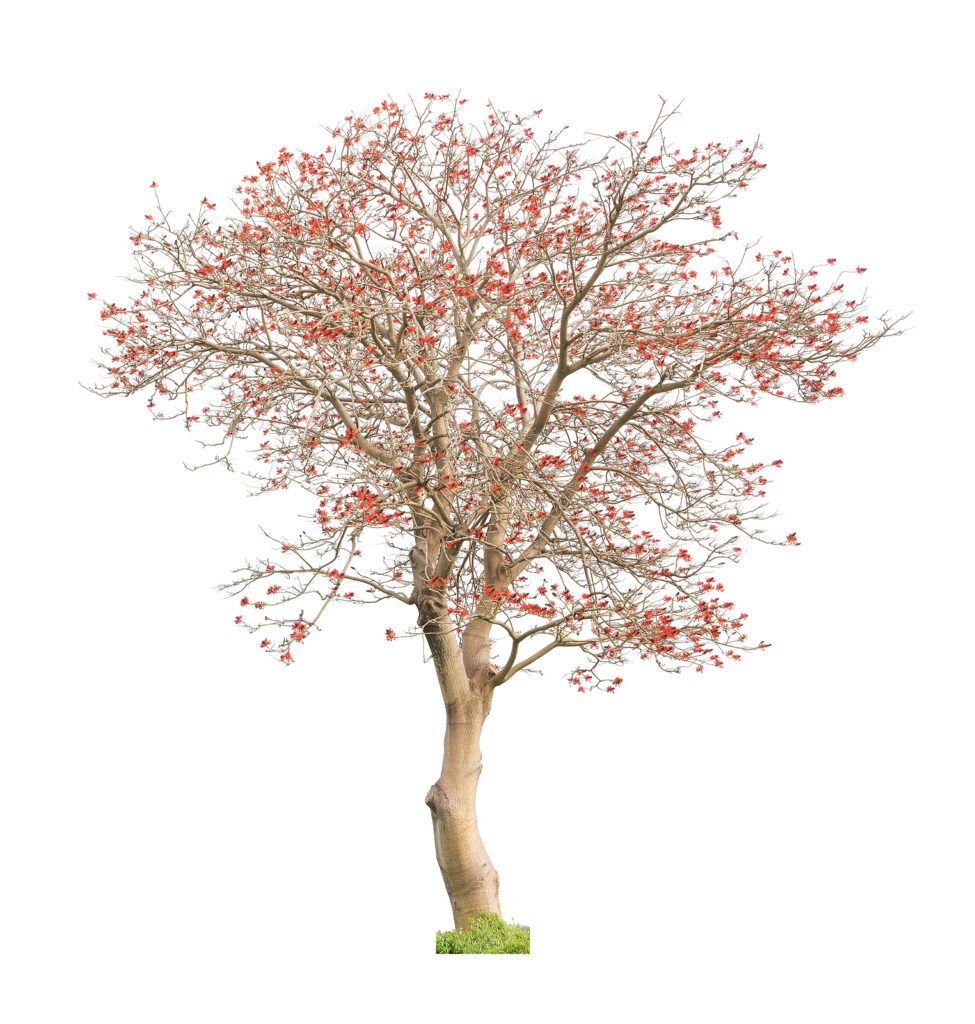Erythrina — commonly called Coral Tree–is grown for its brilliant flowers in colors ranging from greenish white through yellow, light orange, and light red to orange and red. Flowers are borne singly or in clusters in the leaf axial or on terminal racemes
Erythrina is native to woodland and thickets in tropical regions worldwide. It is commonly grown as a specimen plant where its nearly year-round flowers can be on display. In cool or cold winter regions, it can be grown in a cool or temperate greenhouse.
Erythrina is a genus of more than 100 species of deciduous, semi-evergreen, or evergreen, usually spiny trees, shrubs, sub-shrubs, and perennials.

Get to know Erythrina
- Plant type: Deciduous or nearly evergreen trees or shrubs
- Growing zones and range: Zones 9 and 10
- Hardiness: Hardy to Zone 9
- Height and width: Members of this genus vary greatly in height and width; from 5 to 8 feet (1.5-2.5m) tall to 25 to 50 feet (18-25m) tall and 3 to 5 feet (1-1.5m) to 25 to 50 feet (8-15m) wide.
- Growth rate: Medium
- Form and habit: Open and spreading to rounded
- Foliage: Thorny branches with large three-leaflet leaves; flat, beanlike pods follow flowers and contain poisonous seeds; leaves are usually shed in winter or spring
- Flowers: Great clusters of 2-3 inch (5.1-7.6cm) long flowers, colors range from greenish white through yellow, light orange, and light red to orange and red
- Bloom time: Intermittently throughout the year, but mostly during hot weather
- Uses: Mid-climate gardens and as dramatic free-standing ornaments
- Common name: Coral Tree
- Botanical name: Erythrina
- Family name: Fabaceae
- Origin: Woodlands and thickets in tropical regions worldwide
Where to plant Erythrina
- Plant Erythrina in full sun.
- Plant Erythrina in almost any soil.

When to plant Erythrina
- Set Erythrina in the garden in spring or autumn.
- Sow Erythrina seed in spring.
Planting and spacing Erythrina
- Space Erythrina according to the size of the variety you are growing at maturity, from 10 to 50 feet (3-15m) apart.
How to water and feed Erythrina
- Give Erythrina regular to moderate water.
- Feed Erythrina with an all-purpose organic fertilizer in spring.
How to care for Erythrina
- To keep Erythrina plants neat and to encourage continued blossoming, cut off each flower spike after the blossoms fade.
- If heavy pruning is required, do it in early spring before new growth starts so that the current season’s stems can produce flowers; wear gloves to protect your hands from the thorns.
Erythrina pests and diseases
- Erythrina is susceptible to fungal root rot and leaf spot.
- Erythrina seeds are poisonous if ingested.
Erythrina propagation
- Propagate Erythrina from softwood cuttings of young growth in late spring or early summer.
- Sow seed in very warm soil in spring.

Erythrina varieties to grow
- Erythrina acanthocarpa, Tambookie thorn, deciduous shrub, to 3 feet (.9m) tall, rarely 6 feet (1.8m). Bluish-green leaflets to 1.5 inch (3.8cm) are as broad as long. Spring flower spikes are 7 inches (17.8cm) long, 6 inches (15.2cm) wide, with scarlet, yellow-tipped flowers. Thorny plants grow from large, thick tuberlike root.
- E. americana, deciduous tree (but may be evergreen in mildest areas). Native to Mexico; used as street tree in Mexico City. To 25 feet (7.6m) tall. Resembles E. coralloides in habit and flowers.
- E. bidwillii, Bidwill’s coral tree, a hybrid series with flower spikes up to 2 feet (.6m) long, puts it on its biggest display in midsummer, although flowers may also appear 8-10 feet (2.4-3.1m) tall with equal spread, but old plants unscathed by frost may reach twice that height. Cut back flowering wood when flowers are spent. Very thorny, so plant away from paths and prune with long-handled shears.
- E. caffa (E. constantiana), Kaffirboom coral tree, briefly deciduous tree. Native to South Africa. Grows 25-40 feet (7.6-12.2m) high, spreads 40-60 feet (12.2-18.3m) wide. Drops leaves in January; then angular bare branches produce big clusters of deep red-orange, tubular flowers that drip nectar. In March or earlier, flowers give way to fresh, light green foliage.
- E. corralloides, Naked coral tree, deciduous tree. Native to Mexico. To 30 feet (9.1m) high and as wide or wider, but easily contained by pruning. Fiery red blossoms like fat candles or pine cones bloom at tips of naked, twisted, black-thorned branches in spring. At end of flowering season, 8-10 inches (20.3-25.4cm) leaves develop, give shade in summer, turn yellow in late fall before dropping. Bizarre form of branch structure when tree is out of leaf is almost as valuable as spring flower display. Someties sold as E. poianthes.
- E. crista-galli, Cockspur coral tree, deciduous shrub or small tree 15-20 feet (4.6-6.1m) high and wide in nearly frostless areas; perennial to 4 feet (1.2m) in colder part of range. Native to eastern South America. First flowers form after leaves come in spring—at each branch tip is a big, loose, spikelike cluster of velvety, birdlike blossoms in warm pink to wine red (plants vary). Depending on environment there can be as many as three distinct flowering periods, spring through fall. Cut back old flower stems and dead branch ends after each wave of bloom.
- E. falcata, nearly evergreen tree. Native to Brazil and Peru. Grows upright to 30-40 feet (9.1-12.2m) high. Must be in ground several years before it flowers (may take 10 to 12 years). Rich deep red (occasionally orange-red), sickle-shaped flowers in hanging, spikelike clusters at branch ends in late winter, early spring. Some leaves fall at flowering time.
- E. herbacea, Cherokee bean, Coral bean, native to southeastern states, Texas, northern Mexico. Perennial to 6 feet (1.8m) tall in colder parts of range, deciduous shrub or small tree to 15 feet (4.6m) in warmer zones. Bright red, 2 inch (5.1cm) flowers in 8-12 inch (20.3-30.5cm) spikes appear from spring to frost. Red seeds that follow are attractive and extremely poisonous.
- E. humeana, Native coral tree, normally deciduous shrub or tree (sometimes almost evergreen). Native to South Africa. May grow to 30 feet (9.1m) but begins to wear its bright orange-red flowers when only 3 feet (.9m) high. Blooms continuously from late summer to late fall, carrying flowers in long-stalked clusters at branch ends well above foliage (unlike many other types). Dark green leaves. ‘Raja’ is shrubbier and has leaflets with long, pointed “tails.”



